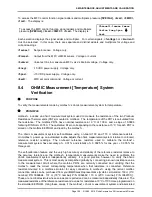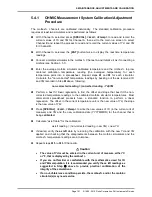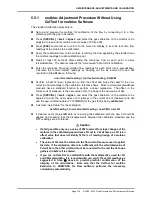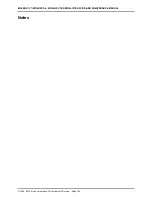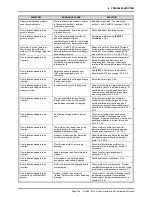
5. MAINTENANCE, ADJUSTMENTS AND CALIBRATION
Page 147
© 1995 - 2010 Fluke Corporation, DH Instruments Division
Both RPTs are normally calibrated simultaneously. The standard calibration
procedure is:
Set-up and prepare the for calibration of the RPT(s) (see Sections 5.2.2,
5.2.3).
Press
[SPECIAL]
,
<4cal>
,
<1pres>
,
<1upstrm>
,
<2view>
to read and record the current
values of
PA
and
PM
for the upstream RPT. Then repeat the process selecting
<2dnstrm>
to read and record the downstream RPT
PA
and
PM
(see Section 5.2.4.2).
Press
[SPECIAL]
,
<4cal>
,
<1pres>
,
<1upstrm>
or
<2dnstrm>
,
<1run>
to display the
real time pressure readings of the RPT(s) to be calibrated (see Section 5.2.4.1).
Apply the calibration pressures to the RPT(s) recording the pressure applied by the
standard and the RPT readings at each calibration point.
See the beginning of section 5.2.2 for the standard calibration range for the RPTs. Dwell
at least 60 seconds after setting the reference pressure at each point to allow
full stabilization. The data recorded is the "as received" data for this calibration.
Enter the calibration pressure and RPT readings for each point into a spreadsheet.
Calculate the "non-corrected" RPT readings by backing out the as received
PA
and
PM
recorded in Step
above, following:
non-corrected reading = (corrected reading - PA)/PM
Perform a best fit linear regression to find the offset and slope that best fit the non-
corrected RPT readings to the calibration standard pressures. Most commercial
spreadsheet products have a standard function to perform a linear regression.
The offset, in Pascal [Pa], is the new value of
PA
, the slope is the new value of
PM
.
Press
[SPECIAL]
,
<4cal>
,
<1pres>
,
<1upstrm>
or
<2dnstrm>
,
<2edit>
to write the new
values of
PA
(always in Pascal) and
PM
and the new calibration date (YYYYMMDD) for
the RPT that is being
calibrated
.
Calculate “as left data" for the calibration:
as left reading = (non-corrected reading • new PM) + new PA
If desired, verify the
as left
data by rerunning the calibration with the new
PA
(s) and
PM
(s) applied and checking that the disagreements between the calibration standard and
the RPT readings are in tolerance.
Caution
•
The value of PA must be entered in the pressure unit Pascal [Pa]. If the
calibration data is in a unit other than Pascal, the calculated value of PA
will be in the other unit and must be converted to Pascal before it is
entered (see Section 7.1.1 for pressure unit conversions).
•
If you are not familiar or comfortable with the mathematics used for PA
and PM manipulation, it is recommended you verify the as left readings as
suggested in Step
above to provide practical confirmation of the
integrity of the calculations. Note also that the CalTool for RPTs software
delivered with the performs the necessary calculations
automatically.

















